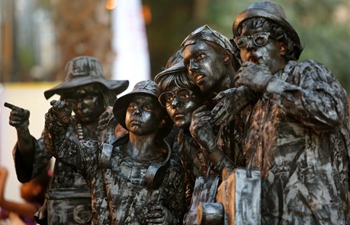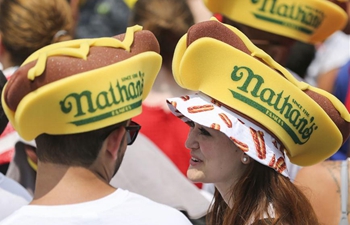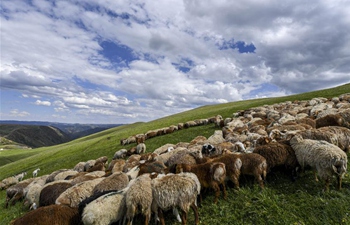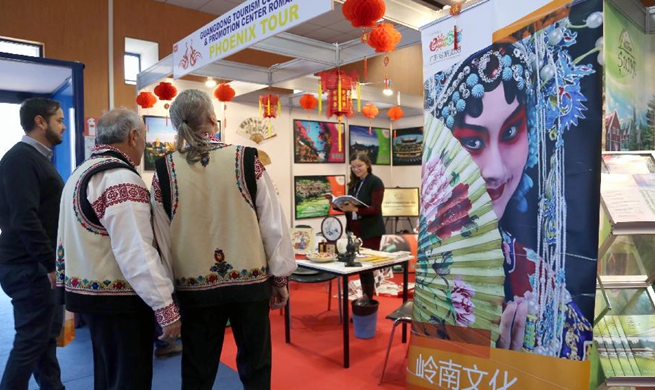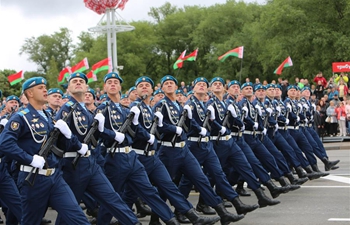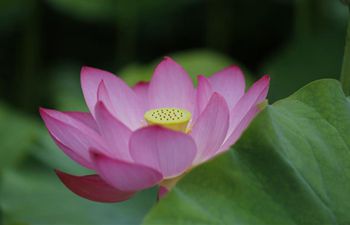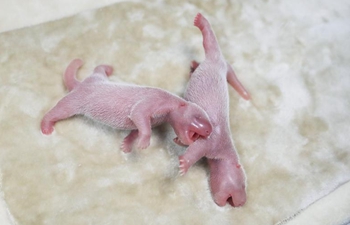PRAGUE, July 4 (Xinhua) -- An international team of scientists and zoologists from Germany, Italy and the Czech Republic managed to artificially develop an embryo of the northern white rhinos, virtually extinct mammals with no living male existent, a Czech zoo said Wednesday in a statement.
At the moment, there are only two known rhinos of this subspecies left alive. Both of them are females, which makes the northern white rhinoceros functionally extinct.
The two animals -- named Najin and her daugther Fatu -- live in the Ol Pejeta Conservancy in Kenya and belong to the Dvur Kralove Zoo in the Czech Republic.
Scientists developed a hybrid embryo by combining the sperm of the northern white rhino and the egg of the southern white rhino, which population is currently estimated at around 21,000 individuals, according to the zoo statement.
For rhinoceroses, this is the first case when the blastocyst, the early stage of embryo development, has been achieved at the laboratory.
Director of the Dvur Kralove Zoo Premysl Rabas said it was a real breakthrough to rescue the critically endangered animal.
"Using artificial methods of reproduction is a major step towards the birth of the first northern white rhino baby. In fact, half of the genetic information of this hybrid embryo comes from the white northern rhinoceros, which is an amazing success," Rabas was quoted as saying.
Thomas Hildebrandt, head of the Department of Reproduction Management at the Berlin-based Leibniz Institute for Zoo and Wildlife Research (IZW), said that the progress could be a great chance that after embryos are inserted into the womb of the surrogate mother, this female will be pregnant.
In order to create a hybrid embryo, the team of scientists used an adapted technique of artificial insemination of horses.
Frozen samples of sperm from the last male species of the northern white rhino in the world, named Sudan who died in March this year in Kenya at old age, were used to produce the embryo.
As for the female eggs, they were taken from the southern white rhinoceros from several European zoo parks, including the Dvur Kralove Zoo. For safe collection of female bio-material, the zoologists used a recently patented instrument with a length of nearly two meters.
The female eggs ended in the laboratory of Avantea in Italy, the world's leader in artificial reproduction for large animals.
"In our laboratory, we have developed methods in order to mature the eggs and its fertilization [...] using a microneedle inserted into the cytoplasm of the egg," said a representative Cesare Galli from Avantea.
"As for the cattle or horses, these methods have been applied for a long time, but it has been the first time with rhinos, when the blastocyst was successfully created," said the representative.
Several embryos are now frozen and preserved for future insertion into surrogate mothers.
Now scientists face another challenge of getting female eggs from the last two females living in Kenya in order to create a clean embryo.
Zoologist say that due to the fact that the number of genuine reproduction material of northern white rhinos is limited to four individual donors, this dramatically narrows down the base required to create a viable population for maintaining sufficient genetic diversity.
That is why scientists, alongside with artificial reproduction methods, also work on stem cells development derived from the stem cells obtained from the northern white rhinoceros that have been preserved in the past.
"We are now able to acquire embryonic stem cells related to southern white rhinoceroses that contain all the properties of an undifferentiated cell with a high ability to differentiate," Galli said.
The combination of stem cell research with newly developed artificial insemination technology provides scientists with a way to save critically endangered mammalian species.
